“The villages of Agracoes and Povoa de Agracoes in northern Portugal look little alike - one is a run-down cluster of dilapidated old stone houses, the other has a cosier feel, with a flower-bedecked wayside shrine and chapel. But the one thing they have in common is the “slow agony” of abandonment, as some villagers say. The steady drip-drip of emigration has brought down their numbers from more than 50 residents to fewer than a dozen each. These remaining villagers share the same glum acceptance that, after they have gone, their villages will die out too. It is the same desolate picture in scores of other backwater settlements in Portugal's interior, north to south. There are no shops. A grocery truck comes once a week and elderly residents taxi pool to see a doctor miles away. “This place will get overgrown with woods for wildfires to burn, that's what will happen ... My daughters won't come to live here, so my land will disappear”, said Antonio Goncalves Fontes, at 62 one of the youngest residents of Agracoes, where mountain waters gurgle next to crumbling stone houses. He and his wife Maria grow chestnuts, vegetables and have a small flock of sheep and five donkeys.
Mass emigration to wealthier countries like France and Switzerland, high unemployment and poorly-paid local jobs, combined with falling birth rates, have caused some parishes like Loivos, which encompasses Agracoes, to lose about three-quarters of the population in the past few decades. The remote Trans-Mountain region of western Europe's poorest country, near the Spanish border, is one of the worst affected. As the population has dwindled, schools and medical outposts have been shut down, causing a vicious circle of ever greater abandonment. In Povoa de Agracoes, which has paved streets where some houses have been renovated out of the pocket of emigre children, Laurinda de Jesus, a pensioner of 80, says with a whimper: “I needed to see a doctor urgently for a pain, but had to wait for a taxi for hours. It's a sad misery of a life here”.
Parliament deputy Luis Ramos Leite has warned that two-thirds of Portugal's territory could become depopulated leading to a decline in economic activity, higher infrastructure costs and worsening living conditions. “For small villages it's a slow agony which, unfortunately, will go on”, he said. “Our battle line has to be in and around the seats of district councils and some larger villages, where it's still possible to stop the process and reverse it”. The nearest such centre is Chaves, a town of 40,000, where residents report a trend of locals returning from larger cities, attracted by business opportunities in tourism. But Frederico Lucas, whose Portugal-wide New Settlers project supports city dwellers eager to set up shop in sparsely populated areas, says that “for a hundred people leaving the interior, we see one going the opposite way”. Ramos Leite says that while other countries also suffered from depopulation, in Portugal it started later, with the bulk occurring after hefty investment in road, power, and water networks in the past two decades. “Infrastructure has failed to prevent depopulation. Now it also poses the question - how is it to be maintained?”. – Rafael Marchante and Andrei Khalip via Reuters
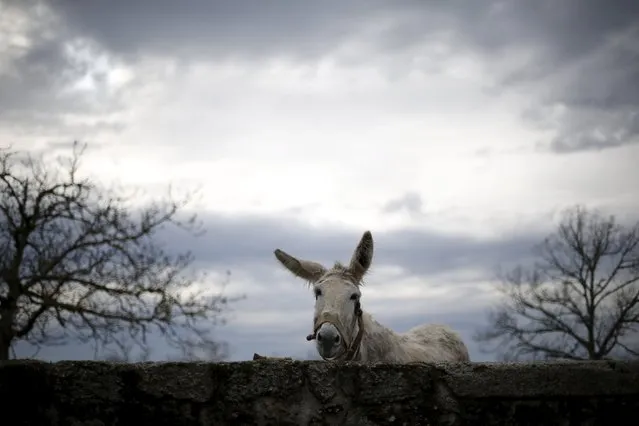
A donkey stays inside a pen in Povoa de Agracoes near Chaves, Portugal, April 18, 2016. In the villages of Agracoes and Povoa de Agracoe, the steady drip-drip of emigration has brought down population numbers from more than 50 residents to fewer than a dozen each. These remaining villagers share the same glum acceptance that, after they have gone, their villages will die out too. It is the same desolate picture in scores of other backwater settlements in Portugal's interior, north to south. (Photo by Rafael Marchante/Reuters)
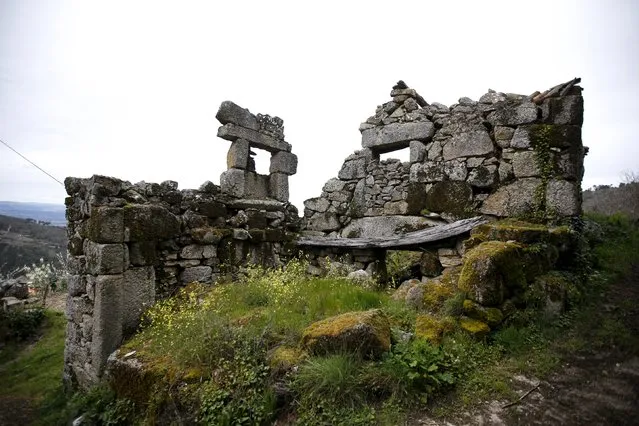
The remains of an abandoned house are seen in Agracoes near Chaves, Portugal, April 18, 2016. (Photo by Rafael Marchante/Reuters)
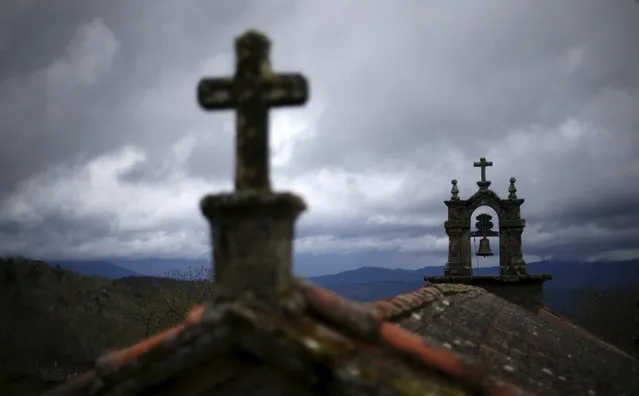
The bell tower of the church is seen in Povoa de Agracoes near Chaves, Portugal, April 19, 2016. (Photo by Rafael Marchante/Reuters)
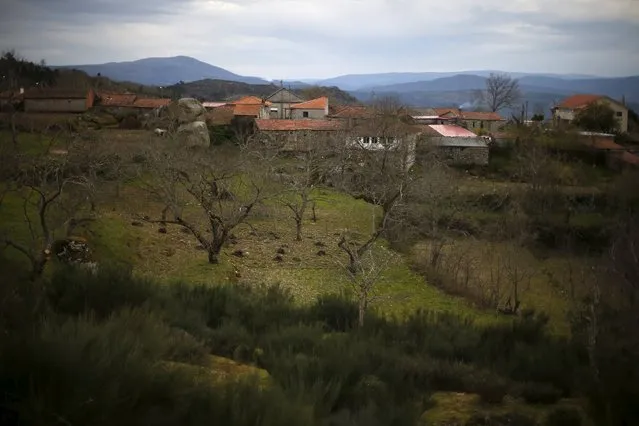
General view of Povoa de Agracoes near Chaves, Portugal, April 18, 2016. (Photo by Rafael Marchante/Reuters)

Maria Jesus poses for a portrait at a street in Povoa de Agracoes near Chaves, Portugal, April 18, 2016. (Photo by Rafael Marchante/Reuters)
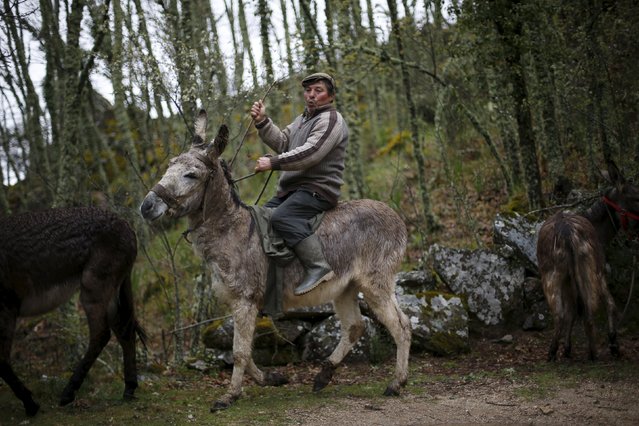
Antonio Fontes rides a donkey near Agracoes, near Chaves, Portugal April 19, 2016. (Photo by Rafael Marchante/Reuters)
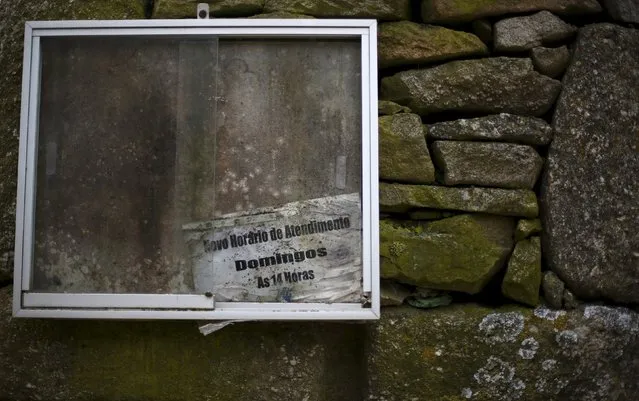
A board shows the attendance timetable of parish council in Agracoes near Chaves, Portugal, April 18, 2016. (Photo by Rafael Marchante/Reuters)
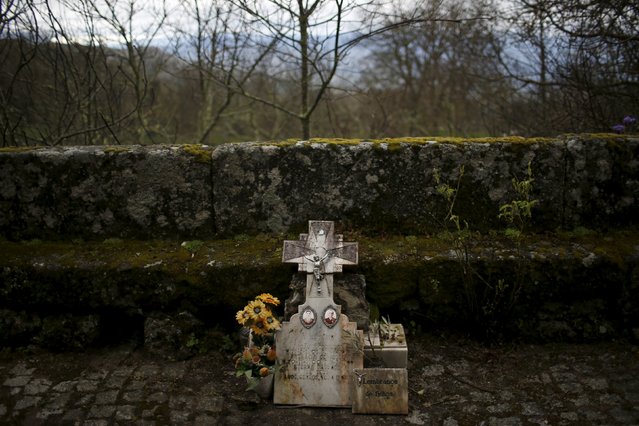
A tombstone is seen next to the church in Povoa de Agracoes near Chaves, Portugal, April 19, 2016. (Photo by Rafael Marchante/Reuters)
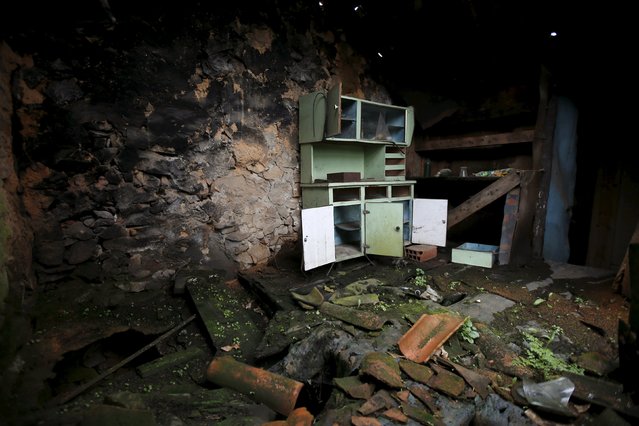
The interior of an abandoned house is seen in Agracoes, near Chaves, Portugal April 18, 2016. (Photo by Rafael Marchante/Reuters)
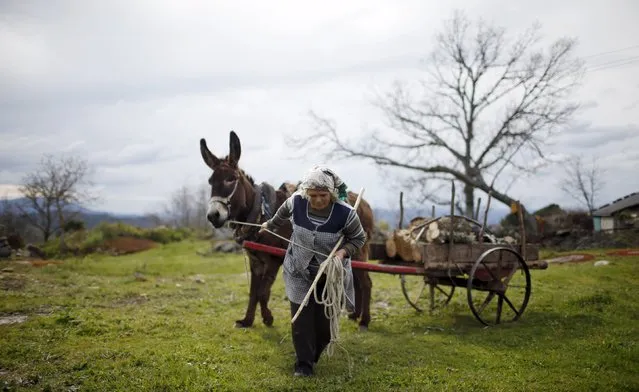
Mariana Teixeira pulls of a cart with firewood in Povoa de Agracoes, near Chaves, Portugal April 18, 2016. (Photo by Rafael Marchante/Reuters)
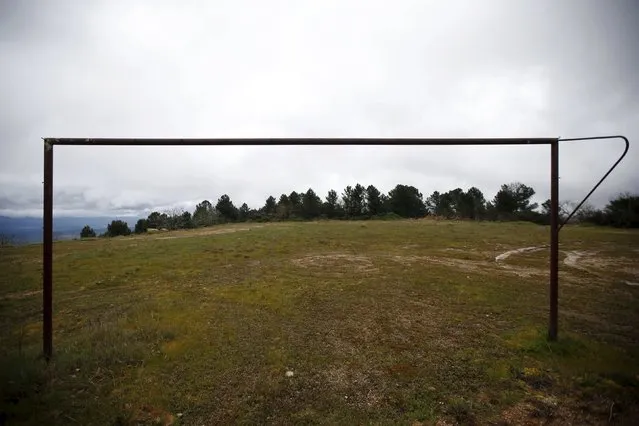
An abandoned goalpost is seen on the outskirts of Povoa de Agracoes, near Chaves, Portugal April 19, 2016. (Photo by Rafael Marchante/Reuters)
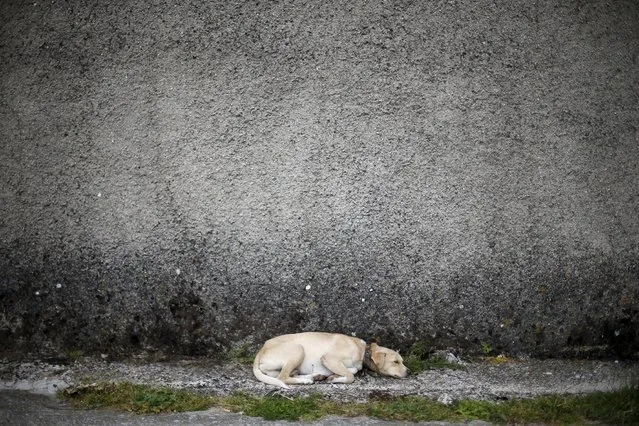
A dog sleeps at a street in Povoa de Agracoes, near Chaves, Portugal April 18, 2016. (Photo by Rafael Marchante/Reuters)
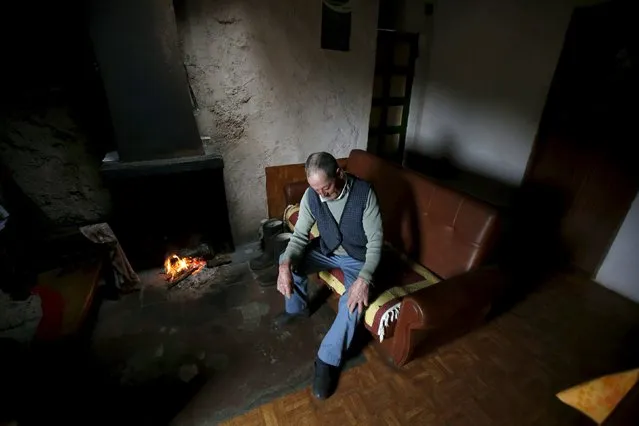
Fernando rests on a sofa inside his house in Povoa de Agracoes, near Chaves, Portugal April 19, 2016. (Photo by Rafael Marchante/Reuters)

Maria Fontes poses for a portrait inside her house in Agracoes, near Chaves, Portugal April 18, 2016. (Photo by Rafael Marchante/Reuters)
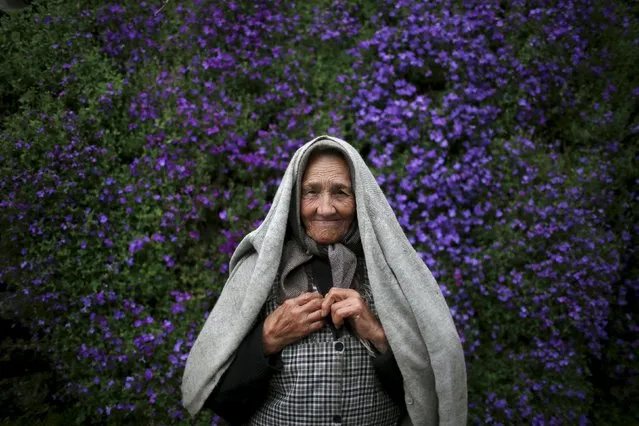
Zulmira Jesus poses for a portrait at a street in Povoa de Agracoes, near Chaves, Portugal April 19, 2016. (Photo by Rafael Marchante/Reuters)
Mass emigration to wealthier countries like France and Switzerland, high unemployment and poorly-paid local jobs, combined with falling birth rates, have caused some parishes like Loivos, which encompasses Agracoes, to lose about three-quarters of the population in the past few decades. The remote Trans-Mountain region of western Europe's poorest country, near the Spanish border, is one of the worst affected. As the population has dwindled, schools and medical outposts have been shut down, causing a vicious circle of ever greater abandonment. In Povoa de Agracoes, which has paved streets where some houses have been renovated out of the pocket of emigre children, Laurinda de Jesus, a pensioner of 80, says with a whimper: “I needed to see a doctor urgently for a pain, but had to wait for a taxi for hours. It's a sad misery of a life here”.
Parliament deputy Luis Ramos Leite has warned that two-thirds of Portugal's territory could become depopulated leading to a decline in economic activity, higher infrastructure costs and worsening living conditions. “For small villages it's a slow agony which, unfortunately, will go on”, he said. “Our battle line has to be in and around the seats of district councils and some larger villages, where it's still possible to stop the process and reverse it”. The nearest such centre is Chaves, a town of 40,000, where residents report a trend of locals returning from larger cities, attracted by business opportunities in tourism. But Frederico Lucas, whose Portugal-wide New Settlers project supports city dwellers eager to set up shop in sparsely populated areas, says that “for a hundred people leaving the interior, we see one going the opposite way”. Ramos Leite says that while other countries also suffered from depopulation, in Portugal it started later, with the bulk occurring after hefty investment in road, power, and water networks in the past two decades. “Infrastructure has failed to prevent depopulation. Now it also poses the question - how is it to be maintained?”. – Rafael Marchante and Andrei Khalip via Reuters

A donkey stays inside a pen in Povoa de Agracoes near Chaves, Portugal, April 18, 2016. In the villages of Agracoes and Povoa de Agracoe, the steady drip-drip of emigration has brought down population numbers from more than 50 residents to fewer than a dozen each. These remaining villagers share the same glum acceptance that, after they have gone, their villages will die out too. It is the same desolate picture in scores of other backwater settlements in Portugal's interior, north to south. (Photo by Rafael Marchante/Reuters)

The remains of an abandoned house are seen in Agracoes near Chaves, Portugal, April 18, 2016. (Photo by Rafael Marchante/Reuters)

The bell tower of the church is seen in Povoa de Agracoes near Chaves, Portugal, April 19, 2016. (Photo by Rafael Marchante/Reuters)

General view of Povoa de Agracoes near Chaves, Portugal, April 18, 2016. (Photo by Rafael Marchante/Reuters)

Maria Jesus poses for a portrait at a street in Povoa de Agracoes near Chaves, Portugal, April 18, 2016. (Photo by Rafael Marchante/Reuters)

Antonio Fontes rides a donkey near Agracoes, near Chaves, Portugal April 19, 2016. (Photo by Rafael Marchante/Reuters)

A board shows the attendance timetable of parish council in Agracoes near Chaves, Portugal, April 18, 2016. (Photo by Rafael Marchante/Reuters)

A tombstone is seen next to the church in Povoa de Agracoes near Chaves, Portugal, April 19, 2016. (Photo by Rafael Marchante/Reuters)

The interior of an abandoned house is seen in Agracoes, near Chaves, Portugal April 18, 2016. (Photo by Rafael Marchante/Reuters)

Mariana Teixeira pulls of a cart with firewood in Povoa de Agracoes, near Chaves, Portugal April 18, 2016. (Photo by Rafael Marchante/Reuters)

An abandoned goalpost is seen on the outskirts of Povoa de Agracoes, near Chaves, Portugal April 19, 2016. (Photo by Rafael Marchante/Reuters)

A dog sleeps at a street in Povoa de Agracoes, near Chaves, Portugal April 18, 2016. (Photo by Rafael Marchante/Reuters)

Fernando rests on a sofa inside his house in Povoa de Agracoes, near Chaves, Portugal April 19, 2016. (Photo by Rafael Marchante/Reuters)

Maria Fontes poses for a portrait inside her house in Agracoes, near Chaves, Portugal April 18, 2016. (Photo by Rafael Marchante/Reuters)

Zulmira Jesus poses for a portrait at a street in Povoa de Agracoes, near Chaves, Portugal April 19, 2016. (Photo by Rafael Marchante/Reuters)
29 Apr 2016 12:05:00,
post received
0 comments
